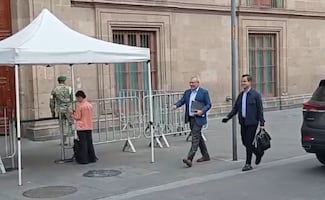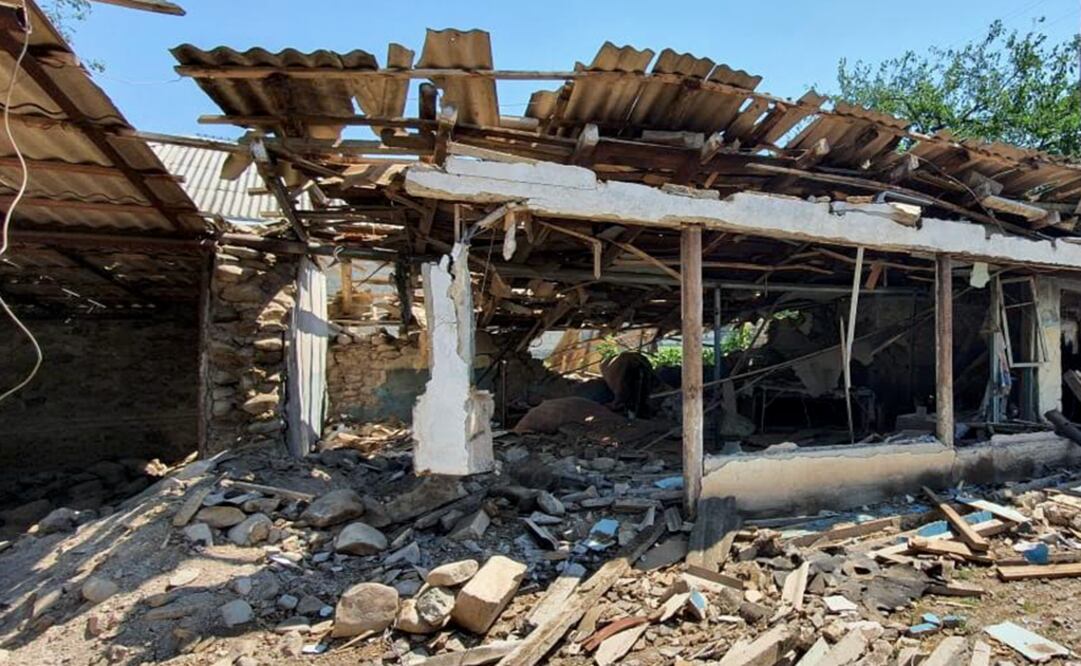Más Información

Senador del PT propone crear televisión, radio y periódico de la 4T; debemos hacer frente a medios de derecha, dice

César Duarte comparece ante jueza en penal del Altiplano; buscan vincularlo por presunto lavado de dinero

¿Qué es el Tratado de Aguas de 1944 entre México y EU por el que Trump amaga con imponer aranceles?; te explicamos

Gobernador de Michoacán se reúne con Sheinbaum en Palacio Nacional; acude también gabinete de Seguridad

Posponen en el Senado discusión y votación de reforma para crear la figura de “jueces sin rostro”; se discutirá en febrero

VIDEO Hallan a pareja sin vida en colonia Lindavista; una de las víctimas era abogado que litigó temas de despojos en Ecatepec
Recent military clashes between Armenia and Azerbaijan have alarmed the international community over the risk of yet another war in the Caucasus, this time involving key energy and trade routes.
On July 12, according to conflicting versions of the facts, Azerbaijani and Armenian forces launched several attacks on their positions across the border in the Armenian district of Tavush and the Azerbaijani Tovuz. The clashes included the use of artillery and, for the first time, drones for precision strikes and reconnaissance.
The danger of an escalation was highlighted on July 16, when the Azeri government threatened its neighbour with a missile attack on the nuclear power plant of Metsamor . The facility is only 36 kilometers from the capital Yerevan , and provides almost half of Armenia’s electricity generating 408 MW.
However, Azerbaijan’s Embassy in Mexico City pointed out to EL UNIVERSAL in English that a similar threat was made by Armenia against the Mingachevir dam , the largest hydroelectric power station in the South Caucasus, endangering the lives of hundreds of thousands. This accusation was in turn rejected by the Armenian Embassy.
The skirmishes continued in the following days until July 21, leaving 16 dead people on both sides, including a major general and a colonel from Azerbaijan’s army. Russia, the European Union, and the United States called separately for an immediate ceasefire and the resumption of peace talks.
It was the worst outbreak of hostilities since 2016, when scores were killed during the so-called “ Four-Day War .” Then, Azeri forces launched assaults along the Line of Contact established in 1994, provoking large-scale confrontations with the army of the pro-Armenian, separatist region of Nagorno Karabakh, said the Armenian authorities. A ceasefire was reached in Moscow on April 5, 2016.
Azerbaijan and Armenia fought the first war in the former Soviet Union in 1988, after the Armenian majority of the autonomous Azeri region of Nagorno (Upper) Karabakh declared its intention to break away from Azerbaijan. In a referendum unrecognized by the government of Baku held on December 10, 1991, days before the collapse of the Soviet Union, the population voted in favor of independence.
The war left around 30,000 people dead; thousands were internally displaced. The Ceasefire Accord , which went into effect on May 1994, formally put an end to combats, yet sporadic fighting in the region breaks out time and again.
A Republic of Artsakh was proclaimed in Nagorno Karabakh in 1991, yet the territory is internationally recognized as part of Azerbaijan by the United Nations, including Mexico.
Since 1994, the Organization for Security and Cooperation in Europe (OSCE) Minsk Group, a mission co-chaired by France, the U.S., and Russia, has been spearheading efforts toward a peaceful solution.
Regarding the fighting in Tavush earlier this month, the Armenian Embassy in Mexico City told this newspaper that after the 2016 Four-Day War Yerevan and Baku agreed to establish ceasefire investigation mechanisms as a result of Russian mediation. Nevertheless, it stressed, they were subsequently rejected by Azerbaijan .
The diplomatic representation noted the Azeri President Ilham Aliyev recently said that “he saw no point in pursuing negotiations for the peaceful resolution of the Nagorno Karabakh conflict.” Aliyev returned “to the ultra-military rhetoric against Armenia , declaring that the entire Armenian territory as well as Yerevan are historical homelands of Azerbaijan,” it added.
Peace and security
For its part, the Azeri embassy remarked that “the greatest threat to peace and security in the region is the occupation of 20% of the sovereign territory of Azerbaijan by Armenia—the Nagorno Karabakh region and seven adjacent districts.”
The embassy accused Armenia of ethnic cleansing against 800,000 Azerbaijanis in the occupied territories. It underscored that four resolutions of the UN Security Council, as well as other documents from international bodies, including the OSCE and the European Council demand the immediate liberation of all occupied territories in Azerbaijan, and the return of displaced people to their homes.
During the Tavush / Tovuz standoff a leading role was assumed by Turkey in support of Baku. Turkey’s President Recep Tayyip Erdogan said that Yerevan’s “deliberate offensive” was “an affair beyond Armenia’s caliber.” Its goal, he argued, was to block settlement efforts in Nagorno Karabakh and “create new conflict zones.”
Following talks in Ankara with Azerbaijan’s Deputy Defense Minister, Ramiz Tahirov, the Turkish Defense Minister, Hulusi Akar, warned that the Armenians “will drown in the ploy they have started and will definitely pay for their actions.”
“The pain of Azerbaijani Turks is our pain,” emphasized Akar. “The blood of our Azerbaijani brothers will not remain unavenged.”
Turkey
’s Embassy in Mexico City was consulted on this matter by EL UNIVERSAL in English , as well as on the risk of an escalation due to Ankara’s offer of weapons to Baku.
In its answer, the diplomatic representation stressed that “Turkey strongly condemns recent military aggression by Armenia against Azerbaijan, which was a blatant breach of international law. To prevent any escalation, all responsible actors of the international community should call on Armenia to desist from further hostility against Azerbaijan.”
Turkey “fully supports territorial integrity of Azerbaijan and is ready to provide appropriate assistance as necessary. Turkey will continue to uphold international law, stand against belligerents, strive to peacefully end conflicts and promote stability and shared prosperity in our region,” it added.
Regional and international media reports underlined that the conflict erupted amid the coronavirus pandemic, rising unemployment, and economic difficulties affecting both Armenia and Azerbaijan.
In the case of Turkey, they noted the convenience for Erdogan to promote ethnic nationalism in a region historically linked to Ankara as a part of the former Ottoman Empire . Other analysts consider that Turkey might be hoping to pressure Russia in the Libyan and Syrian conflicts, where Erdogan is an antagonist of the Kremlin.
A new relevant factor, however, is the complex web of interests surrounding energy and trade routes between Central Asia, the Southern Caucasus , and Europe.
The Baku-Tbilisi-Ceyhan pipeline and the Baku-Tbilisi-Kars railway link Azerbaijan, Georgia and Turkey (dubbed the Middle Corridor ), connecting Europe to Central Asia and China without crossing Russia and Iran. Both run through Azeri territory (Tovuz), about 20 kilometers from the Armenian border.
Under U.S. pressure, reported Al-Monitor , Turkey has moved to reduce energy reliance on Russia and Iran, while Azerbaijan for the first time surpassed Moscow this year in terms of gas supplies to Turkey. Azerbaijan’s South Caucasus Pipeline also runs nearby Tovuz, carrying gas to the Trans-Anatolian Natural Gas Pipeline in Turkey, which is a major component of Turkish and European efforts to reduce their imports from Russia.
Completed in 2019, the Trans-Anatolian pipeline has an annual capacity to carry 16 billion cubic meters of Azeri natural gas to Turkey and from there to southern Europe via the Trans-Adriatic Pipeline under construction.
Moreover, the 7.7 billion cubic meters of Iranian gas and the comparable capacity of the South Caucasus Pipeline , the three non-Russian pipelines passing from the vicinity of Tavush, Armenia, could cover about 50% of Turkey’s demand and 15% of that of Europe, considered the news website.
It detailed that Russia’s Gazprom is likely to remain Turkey’s primary gas supplier in the near future. Still, Ankara is in a stronger negotiating position with a view to their bilateral gas deal expiring in 2021, thanks to enhanced cooperation with Baku and the U.S. threat of energy sanctions.
Speaking on a conference call organized by the U.S.-based think tank Caspian Policy Center on July 18, Elshad Nassirov, Vice president of Azeri state energy company SOCAR, called on the West to help protect oil and gas exports through the Middle Corridor, informed Reuters .
The Middle Corridor is 2,000 km shorter than the Northern Corridor (China-Siberia-Russia) contemplated by Beijing’s Belt and Road Initiative, and takes one-third of the time as the sea route between China and Europe.
“I would use this opportunity to invite our colleagues in Washington and elsewhere to think about how fragile this region is, and to think how to provide military and physical security to the corridor, which is providing energy security to Europe,” stated Nassirov.
Editing by Sofía Danis
More by Gabriel Moyssen
Noticias según tus intereses
[Publicidad]
[Publicidad]








